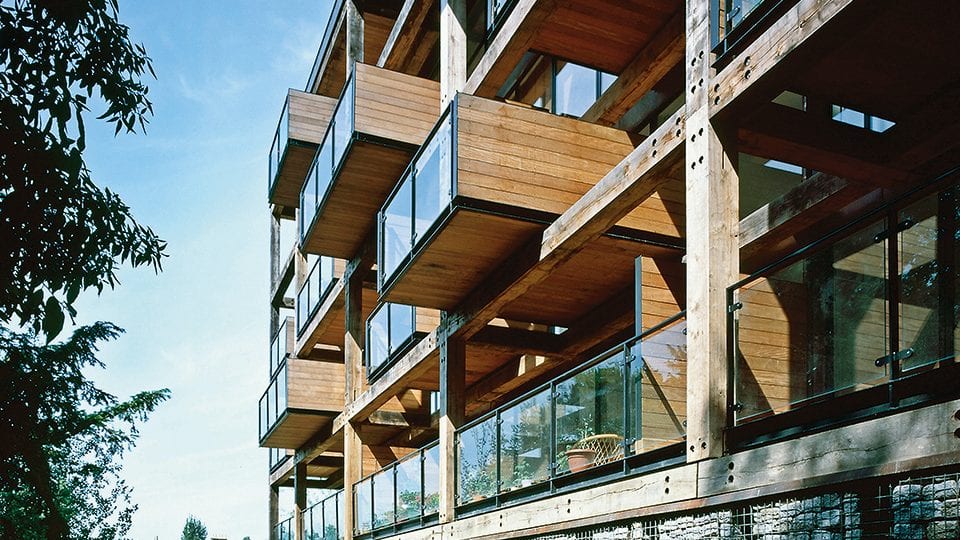Written by Tony Chapman, a new title includes every winner over the last 20 years, highlighting how buildings must move beyond functionality.
“Uniqueness,” observes Tony Chapman, Head of Awards at the Royal Institute of British Architects, and author of The RIBA Stirling Prize: 20, “interests people.” Indeed, even a cursory glance over the Stirling shortlisted and prize-winning buildings from the 20 years since its inception would certainly reveal a smorgasbord of unique works: from those skyline-defining household names such as the iconic Shard and the Gherkin in London to the heritage regeneration success stories such as Astley Castle, or the harbingers of urban regeneration like the Gateshead Millennium Bridge.
Winning the Stirling Prize is largely about making it through a very long and exhaustive process of elimination which includes the criteria of having won both the regional award and the national award. An initial longlist of roughly 500 entries (the number fluctuates considerably, Chapman notes, depending on the economic climate) is gradually and painstakingly whittled down to a final shortlist of six.
At the inception of the prize – and for the first few years of its existence – there used to be a system of categories: but this was quickly abandoned because the organisers felt that it was skewing the judging process. “We couldn’t guarantee these were the best six buildings,” Chapman recalls, adding that the decision was ultimately made to “compare everything them all with each other and choose the best six.”
One-on-one comparison of such diversity is, without a doubt, a complex and nuanced task. The Stirling Prize being “the culmination of the RIBA Awards” means the over-arching aim is to award the building that “[has] had the most influence on architecture” in the year in question. Influence is of course an elusive concept: it’s not synonymous with innovation, although originality and evidence of an innovative approach are also core criteria for selecting the chosen works.
Yet having an impact on other buildings requires more: while Chapman is keen to point out that “architecture is a practical art” and therefore “buildings have to work”, he’s also quick to highlight the fact that for a building to win the Stirling, it needs to go “beyond mere functionality.”
Leafing through The RIBA Stirling Prize: 20, it’s not long before you encounter a building that does just that. There are some truly dramatic examples in the collection, for instance the American Air Museum with its soaring displays, or the sweeping landscape which was created by Zaha Hadid for MAXXI. Such works attest to what the book calls “the power of architecture to shape our experience”. By at once subtly guiding the movement of visitors and encouraging a spirit of exploration, Stirling Prize winners integrate the functionality of a space with the experience of the entire building.
In the text, Chapman mentions that “the challenge of how to be resolutely of the present age whilst simultaneously embracing the past is one of the most complex problems that architects have had to face throughout history.” So how does competing for the Stirling Prize encourage clients and architects to not just be of the present but also to usher in the future? “Buildings,” Chapman declares, “should last. There are some specific structures that are intended to be temporary and are therefore exempt from that exhortation, but I think it’s really important that we do build for posterity, where appropriate.” Preparing for future change by including adaptability in the plans is one of the ways that building for the future can be achieved; and, as Chapman admits, “something that is adaptable takes a lot more thought.”
Another aspect of contemporary building is to recover and breathe new life into the past. Several of the examples in the book integrate past and present, in the form of existing structures being enveloped in (or enveloping) new buildings, such as the Magna Science Adventure Centre re-purposing a former steelworks in Rotherham, Yorkshire. A dramatic example of this is the regeneration of Astley Castle to become a holiday home: a surprising but well-deserving winner.
Love and care of historic architecture has long been part of the fabric of British national identity, ever since the Ancient Monuments Board for England came together in 1913 to ensure the survival and preservation of nationally important monuments, which soon extended to include the protection and conservation of all nationally important built heritage.
The prevailing issue is that not all nationally important historic architecture will attract the same number of visits as Stonehenge or Tintagel. Presently there are “all sorts of listing processes and barriers to redeveloping and knocking down old buildings,” which means that finding creative ways to re-use old buildings and ruined structures is becoming of paramount importance. Whilst public opinion might often reject the idea of modernising interventions in these heritage sites, the question remains: what is the point of having unused and unvisited ruins dotted around the country?
Astley Castle is an interesting case of a historic building that, as Chapman puts it, “wasn’t considered that important; it was not that well known.” Its thoughtful yet confident regeneration by Witherford Watson Mann architects has shown the public a working way forward in the marriage of old and new, and has created huge interest. Awarding Astley Castle the Stirling Prize has gone some way towards highlighting – and changing public perceptions of – the linking of historical and contemporary architecture.
This meeting of past and present is one recurring aspect of the Stirling award-winning and shortlisted architectural projects. Another aspect is the meeting of inner and outer, the opening up of space and the creating of opportunities for movement between the building itself and the world around it. “Architecture,” the judges of the 2002 Stirling Prize noted, “is about the enclosure of space” – in addition, Chapman observes that the “merging of inside and out is [also] considered important in all great architecture.”
Manchester Civil Justice Centre, which was shortlisted for the 2008 prize, incorporates elements that enable transparency, apparent both from the outside in and from the inside out: it allows citizens who walk past to catch a glimpse of the workings of the civil court buildings inside it, and at the same time gives people who have presented themselves to the court a glimpse of the outside world beyond its walls.
Denton Corker Marshall architects chose to literalise the concept of transparency in the administering of justice by using glass in a building that would traditionally have been built as a fortress: awe-inspiring and opaque, a structure designed to create dread in the hearts of those who choose to break the law, whilst re-affirming its seriousness as a centre of the justice system. “[Denton Corker Marshall] turn that on its head,” Chapman observes, and it was that “highly unusual [approach that] made us put it on the shortlist.”
When it comes to great architecture, there should not be any hard and fast boundaries between inside and out: instead, “there should be an element of the outside coming in and the inside coming out, as it were.” Maggie’s House in London and Lanarkshire are at the same time set apart from the outside world and yet integrated in it – they are constructions in which an element of transparency is brought into the design in order to encourage people to enter the building. Maggie’s Centres are places of refuge and healing for people diagnosed with cancer. Sufferers are obviously in a state of high anxiety and if they go to a Maggie’s Centre, they’ve probably only recently been diagnosed with cancer. They might have heard or been recommended to go to this venue where they can meet therapists and other sufferers. The aim of creating a welcoming and transparent space is partly to offer these new arrivals a glimpse of the cosiness that awaits them in the centre: people talking over a cup of tea, having a laugh, relaxing in each other’s presence. However, a balance must be struck: people who use Maggie’s Centres “do not want to feel that they’re on show,” as Chapman puts it. It is important for people who use or might use them to have the opportunity for quiet re ection and to enjoy one’s own space and privacy. “The solution usually opted for,” Chapman notes, “is to carry out a lot of planting to ensure that there’s shade from prying eyes.”
For Chapman, the best examples of architecture both make a distinctive mark on the skyline they are added to and integrate themselves into the fabric of the surrounding area. Considering the fact that the Stirling Prize is awarded to one outstanding building, it’s not surprising that the winner does just that: stand out. He adds: “Of course, if art is going to draw attention to itself, it has to be good. It never says ‘Look at me, aren’t I ugly?’ It’s got to say ‘Look at me, aren’t I beautiful?’” Different architectural approaches might help a building to draw attention to itself, but its beauty has to be more than skin-deep. Chapman juxtaposes billboard architecture – which is just something that is attached to a building that says “Here, look at me”, but when you look deeper you find that there’s nothing else worth looking at – with buildings like the Shard. Although it is a look-at-me building, the Shard was designed in such a way that “the more you look at it, the more complex it is, and the more there is to see and enjoy.” There is certainly something to be said about architecture that doesn’t slavishly adhere to its context. If all buildings were to seamlessly integrate with one another, our cities would end up looking bland and boring. However, great architecture often brings an element of weaving together, of bridging the gaps, both metaphorically and literally. The RIBA Stirling Prize: 20 gorgeously illustrates the way that architecture spans life. “We are all aware,” Chapman muses, “as we walk around a city that some buildings interest us and some don’t. The more people find out about why a building is good and why a building is bad the greater our appreciation and understanding of where we live.” Encompassing the buildings in which we dwell and study; the rooms for work, enjoying music, spending our leisure time; the places in which we receive terrible news or begin to face it; the bridges to cross; the stations to travel through, the Stirling Prize carefully selects works for their achievement in bringing the importance of architecture into the spotlight. An invaluable insight into the judging process, The RIBA Stirling Prize: 20 celebrates the structures that have made a lasting impact on architecture and the way we perceive it.
Regina Papachlimitzou
The RIBA Stirling Prize: 20. Merrell Publishers.





